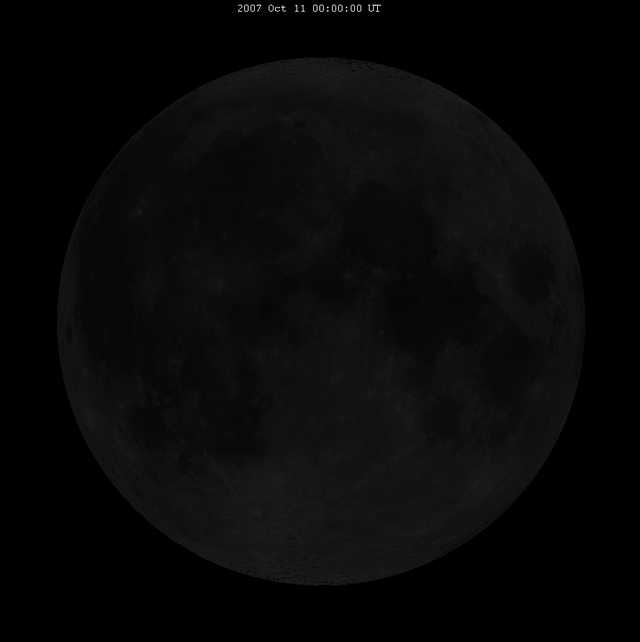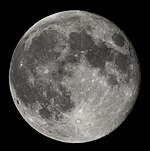Lunar phase
From Wikipedia, the free encyclopedia
| This article does not cite any references or sources. Please help improve this article by adding citations to reliable sources (ideally, using inline citations). Unsourced material may be challenged and removed. (November 2008) |
Lunar phase (or Moon phase) refers to the appearance of the illuminated portion of the Moon as seen by an observer, usually on Earth. The lunar phases vary cyclically as the Moon orbits the Earth, according to the changing relative positions of the Earth, Moon, and Sun. One half of the lunar surface is always illuminated by the Sun (except during lunar eclipses), and is hence bright, but the portion of the illuminated hemisphere that is visible to an observer can vary from 100% (full moon) to 0% (new moon). The boundary between the illuminated and unilluminated hemispheres is called the terminator.
Contents |
[edit] Overview

Lunar phases are the result of looking at the illuminated half of the Moon from different viewing geometries; they are not caused by shadows of the Earth on the Moon that occur during a lunar eclipse. The Moon exhibits different phases as the relative geometry of the Sun, Earth, and Moon change, appearing as a full moon when the Sun and Moon are on opposite sides of the Earth, and as a new moon (also named dark moon, as it is not visible at night) when they are on the same side. The phases of full moon and new moon are examples of syzygies, which occur when the Earth, Moon, and Sun lie (approximately) in a straight line. The time between two full moons (and between successive occurrences of the same phase) is about 29.53 days (29 days, 12 hours, 44 minutes) on average (hence, the concept of a timeframe of a period of time of an approximated month was derived). This synodic month is longer than the time it takes the Moon to make one orbit about the Earth with respect to the fixed stars (the sidereal month), which is about 27.32 days. This difference is caused by the fact that the Earth-Moon system is orbiting about the Sun at the same time the Moon is orbiting about the Earth. The actual time between two syzygies is variable because the orbit of the Moon is elliptic and subject to various periodic perturbations, which change the velocity of the Moon.
It might be expected that once every month when the Moon passes between Earth and the Sun during a new moon, its shadow would fall on Earth causing a solar eclipse. Likewise, during every full moon, we might expect the Earth's shadow to fall on the Moon, causing a lunar eclipse. We do not observe a solar and lunar eclipse every month because the plane of the Moon's orbit around the Earth is tilted by about 5 degrees with respect to the plane of Earth's orbit around the Sun. Thus, when new and full moons occur, the Moon usually lies to the north or south of a direct line through the Earth and Sun. Although an eclipse can only occur when the Moon is either new or full, it must also be positioned very near the intersection of Earth's orbit plane about the Sun and the Moon's orbit plane about the Earth (that is, at one of its nodes). This happens about twice per year, and so there are between 4 and 7 eclipses in a calendar year. Most of these are quite insignificant; major eclipses of the Moon or Sun are relatively rare.
[edit] Names of lunar phases
The phases of the Moon have been given the following names, which are listed in sequential order:
| Phase | Northern Hemisphere | Southern Hemisphere | |||
|---|---|---|---|---|---|
| Darkened moon | Not visible | Not visible | |||
| New moon | Not visible, or traditionally, the first visible crescent of the Moon | ||||
| Waxing Crescent moon . | Right 1-49% visible | Left 1-49% visible | |||
| First Quarter moon | Right 50% visible | Left 50% visible | |||
| Waxing gibbous moon | Right 51-99% visible | Left 51-99% visible | |||
| Full Moon | Fully visible | Fully visible | |||
| Waning gibbous Moon | Left 51-99% visible | Right 51-99% visible | |||
| Last Quarter Moon | Left 50% visible | Right 50% visible | |||
| Waning Crescent Moon | Left 1-49% visible | Right 1-49% visible | |||

When the Sun and Moon are aligned on the same side of the Earth, the Moon is "new", and the side of the Moon visible from Earth is not illuminated by the Sun. As the Moon waxes (the amount of illuminated surface as seen from Earth is increasing), the lunar phases progress from new moon, crescent moon, first-quarter moon, gibbous moon and full moon phases, before returning through the gibbous moon, third-quarter moon, crescent moon and new moon phases. The terms old moon and new moon are interchangeable, although new moon is more common. Half moon is often used to mean the first- and third-quarter moons.
When a sphere is illuminated on one hemisphere and viewed from a different angle, the portion of the illuminated area that is visible will have a two-dimensional shape defined by the intersection of an ellipse and circle (where the major axis of the ellipse coincides with a diameter of the circle). If the half-ellipse is convex with respect to the half-circle, then the shape will be gibbous (bulging outwards), whereas if the half-ellipse is concave with respect to the half-circle, then the shape will be a crescent.
In the northern hemisphere, if the left side of the Moon is dark then the light part is growing, and the Moon is referred to as waxing (moving towards a full moon). If the right side of the Moon is dark then the light part is shrinking, and the Moon is referred to as waning (moving towards a new moon). Assuming that one is in the northern hemisphere, the right portion of the Moon is the part that is always growing.
[edit] Calendar
The average calendrical month, which is 1/12 of a year, is about 30.4 days, while the Moon's phase (synodic) cycle repeats every 29.53 days. Therefore the timing of the Moon's phases shifts by an average of about one day for each successive month. If you photographed the Moon's phase every day for a month, starting in the evening after sunset, and repeating approximately 25 minutes later each successive day, ending in the morning before sunrise, you could create a composite image like the example calendar below from May 8, 2005 to June 6, 2005. Note that there is no picture on May 20 since a picture would be taken before midnight on May 19, and after midnight on May 21. For a similar reason, if you look at a calendar listing moon rise or set times, there will be days where the moon neither rises nor sets.
[edit] See also
[edit] External links
| Wikimedia Commons has media related to: Category:Lunar phases |
- Virtual Reality Moon Phase
- US Naval Service on Moon Phase
- Full Moon Names
- Telescopic moon photos through the phases by Michael Myers
- The Moon Below the Equator
- Current Moon Phase
- The Length of the Lunar Cycle (numerical integration analysis)
[edit] Educational aids
- Starchild: Moonlight Madness Lunar Phases Game
- Quia 3rd Grade SOL 3.8 - Put the Moon's Phases in the Correct Order Game
- Astrophysics Science Project Integrating Research & Education: Lunar Phases Quiz
|
||||||||||||||||||||||||||






